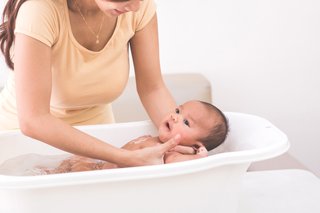Bathtime is a chance for you and your baby to have fun, play and interact. A bath 2 to 3 times a week is enough to keep your baby clean.
Your midwife or public health nurse (PHN) will show you how to bathe your baby for the first time. You can ask to see it done once or twice before you try.
Where to bathe your baby
You can wash your baby in:
- the main bath
- the sink
- their own small baby bath
You can also give your baby a 'top and tail' clean instead of a bath. Or you could have them in the bath with you.
What you need
Have everything you need ready before you start, including:
- a bath, sink, baby bath or basin with warm water
- a clean nappy
- clean clothes
- towels
- cotton wool
Do not use any soap, shampoo or products when they're under 1 month. Plain water is safer for your baby's skin.
Getting ready to bathe your baby
- Get the room ready and warm before you start - babies can get cold quickly.
- Gather everything you need beforehand, including towels, a nappy and clothes.
- Fill the water until it is about 8cm to 10cm deep - or just high enough to cover your baby's tummy.
- Check the temperature by dipping your wrist or elbow in the water - it should be about 36 degrees Celsius.
- Mix the water well so there are no hot patches.
Bathing your baby
- Hold your baby on your knee and clean their face.
- Hold their head over the water and wash their hair.
- Dry their head with a towel.
- Slip off their nappy and wipe their bottom.
- Lift your baby into the water with one arm behind their shoulders and neck, holding their outside arm with your hand.
- Place your other hand under their bottom.
- Lower your baby slowly into the water so they do not feel as though they are falling.
- When their bottom is resting on the floor of the basin or bath, use your free hand to wash them and the other hand to support their head.

Taking your baby out of the bath
After you've bathed your baby:
- Slip your free arm back under their bottom.
- Hold their legs with that arm as they will now be slippery, then lift them out onto the towel.
- Pat them dry, paying attention to skin folds and creases.
- Empty the basin, bath or sink.
Bath safety
Babies under age 1 are at greatest risk of drowning in the bath. Drowning can happen very quickly, without any noise. It can happen in a very small amount of water.
Children who survive near-drowning often have long-term health effects from brain injury.
Important
Never leave your baby alone in the bath, not even for a second. Babies can drown in very little water. They can also be at risk of scalds.
If you need to leave, bring your baby with you. Never let an older child supervise your baby at bath time. Your baby needs adult supervision at all times.
Always empty the bathwater when you are done.
Do not use bath seats
Do not use bath seats. They are not safety equipment. Your baby could slip out, or tip forwards or sideways into the water.
How often to bathe your baby
You do not need to bathe your baby every day. But you can if it relaxes and soothes them.
Two or three baths a week is enough to keep your baby clean. Choose a time when they are not too hungry or tired. It is best not to bathe them directly after a feed.
Bath temperature
Your baby's skin needs cooler water than your own. Water that may feel barely warm to you could be too hot for your baby.
Put the cold water in the basin or bath first. Then put the warm water in. Finally, put cold water in again to make sure the taps are cool and will not burn your baby.
The temperature should be about 36 degrees Celsius. Use a bath thermometer to test this.
Always check the temperature of the bathwater with your elbow. Your hands are not sensitive enough. Mix the water well to ensure there are no 'hot spots'.
Never put your baby in the bath when the water is still running. The water temperature can change quickly.
Make sure the room you are bathing them in is warm. Close windows to prevent a draught.
Amount of water to use
The water level should be just high enough to cover your baby’s tummy when they are lying down. Make sure you always keep your baby's head clear of the water.
Bonding with your baby during bath time
Bath time can be a special bonding time with your baby as you massage and play with them. It will help your baby to relax if you keep talking while you wash them.
After the bath
Dry them and pay particular attention to their skin folds.
This is a good time to massage some oil or cream into your baby’s skin. Do not use aqueous cream for dry skin conditions as it may damage their skin.
Do not use any oils on your baby’s skin if they are under 1 month old. Do not use anything that contains peanut oil, as some babies are allergic to it.